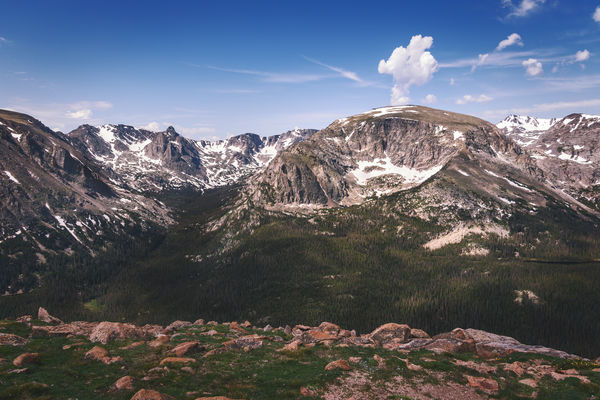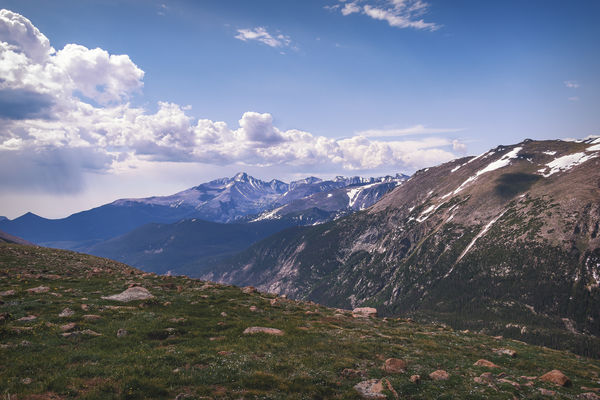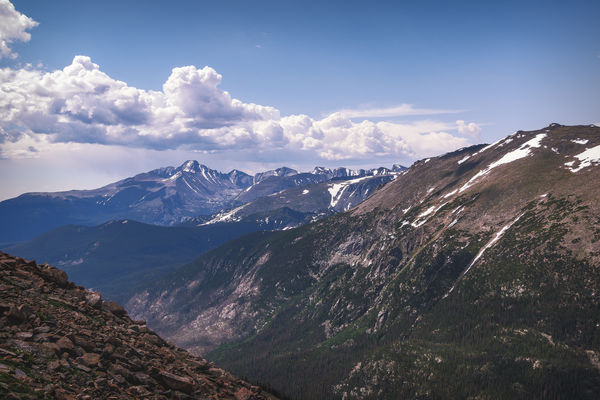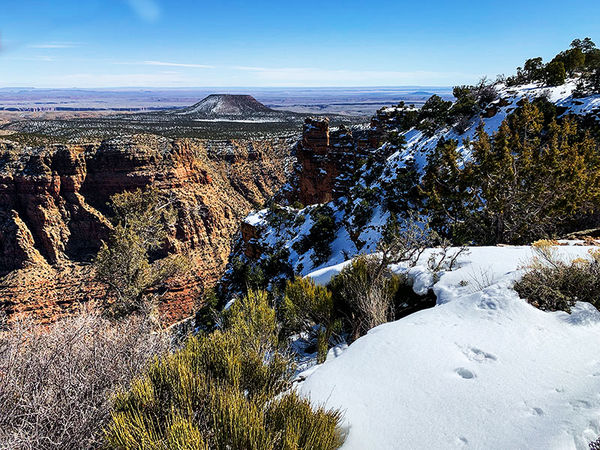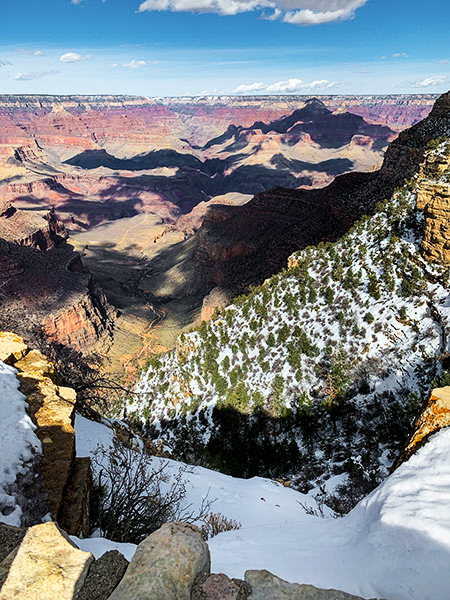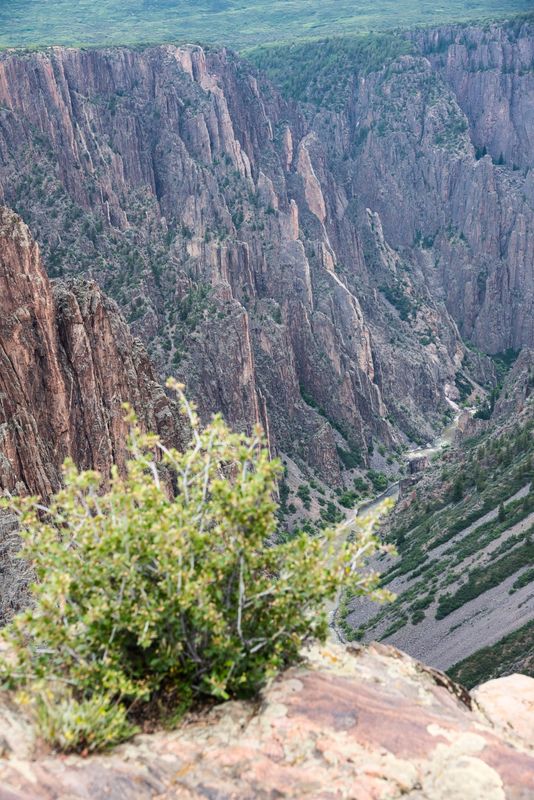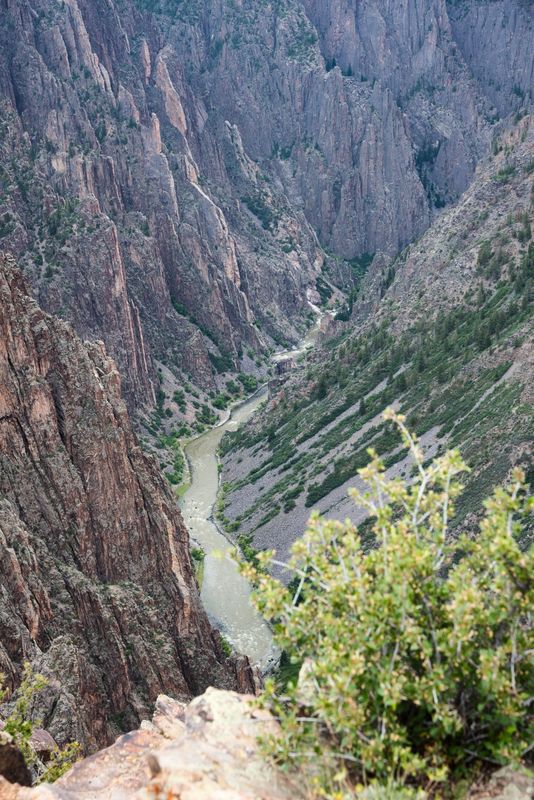Easy as falling off a mountain.
Jul 14, 2019 18:06:35 #
One of the challenges I've had (and still have) with landscape photography is getting the viewer to feel the depth of something like a canyon (or an abyss). Certainly, I can feel that depth when I'm standing on the rim of that canyon (or cliff, or whatever), but how do I imbue my photograph with that feeling?
It is clearly a matter of composition, rather than editing. It seems obvious to me -- now, that is -- that to imbue that feeling of depth, one must include at least a portion of the ground on which one is standing. (I had to take more than a few boring photos, until that sunk in. I had to scrape a few knees while learning how to ride a bike, too.) But how much of that ground, should be included, and how should it be included?
When I'm standing on a cliff, I can look straight out, and appreciate what would happen in I took one forward step too many. That doesn't translate too well, in composition, though. If the edge of the canyon is parallel to the bottom of the photograph, that feeling of depth may not be particularly acute, though it is certainly stronger than if that ground were not included, at all.
Okay, so the rim of the canyon should be on an angle, with respect to the bottom of the photograph. A leading line, if you will, although I'm not sure I want to walk that line.
There is more to it than merely including the foreground on an angle, with respect to the bottom of the frame. It seems that the more acute the angle is, the stronger the feeling of depth (or height, if you will). The angle could get so acute that only a portion of the safe foreground might be included in the frame. That's when things get interesting.
We were up in Rocky Mountain National Park, last Friday. We were just about as high as that particular road would go. I wanted to see if I could capture that feeling of height. I took a few shots, with the edge of the foreground at different angles. (In order to do that, the views have to be different, even though they were all taken in the same viewing area.)
The first shot is with the edge of the foreground parallel, more or less, to the bottom of the frame. The line of the foreground is also roughly parallel to the line formed by the tops of the mountains. The lines do not lead me anywhere. Consequently, the feeling of height, or the depth of the valley between me and the peaks, in the distance, is too subtle for this photo to make much of an impact. I only included it to show the difference between this one and the next two.
The second shot has the edge of the safe ground more on an angle, with respect to the bottom of the frame. That foreground line intersects with the line formed by the mountain tops. That point of intersection is just to the left of the frame. As a viewer, I start to feel the height. (If there were less foreground, yet it still spanned the width of the shot, I think I'd feel that height a bit more acutely.)
In the third shot, the foreground is on a very acute angle, with the foreground only spanning half the width of the frame. The first time I looked at this shot, in full screen, I got the impression that I was about to fall off the mountain. This one had more of an impact, on me, than the second one did.
So, I guess my takeaway is that, if I make sure the foreground line is not parallel to the bottom of the frame, I probably have a better chance of creating some meaningful leading lines.
It is clearly a matter of composition, rather than editing. It seems obvious to me -- now, that is -- that to imbue that feeling of depth, one must include at least a portion of the ground on which one is standing. (I had to take more than a few boring photos, until that sunk in. I had to scrape a few knees while learning how to ride a bike, too.) But how much of that ground, should be included, and how should it be included?
When I'm standing on a cliff, I can look straight out, and appreciate what would happen in I took one forward step too many. That doesn't translate too well, in composition, though. If the edge of the canyon is parallel to the bottom of the photograph, that feeling of depth may not be particularly acute, though it is certainly stronger than if that ground were not included, at all.
Okay, so the rim of the canyon should be on an angle, with respect to the bottom of the photograph. A leading line, if you will, although I'm not sure I want to walk that line.
There is more to it than merely including the foreground on an angle, with respect to the bottom of the frame. It seems that the more acute the angle is, the stronger the feeling of depth (or height, if you will). The angle could get so acute that only a portion of the safe foreground might be included in the frame. That's when things get interesting.
We were up in Rocky Mountain National Park, last Friday. We were just about as high as that particular road would go. I wanted to see if I could capture that feeling of height. I took a few shots, with the edge of the foreground at different angles. (In order to do that, the views have to be different, even though they were all taken in the same viewing area.)
The first shot is with the edge of the foreground parallel, more or less, to the bottom of the frame. The line of the foreground is also roughly parallel to the line formed by the tops of the mountains. The lines do not lead me anywhere. Consequently, the feeling of height, or the depth of the valley between me and the peaks, in the distance, is too subtle for this photo to make much of an impact. I only included it to show the difference between this one and the next two.
The second shot has the edge of the safe ground more on an angle, with respect to the bottom of the frame. That foreground line intersects with the line formed by the mountain tops. That point of intersection is just to the left of the frame. As a viewer, I start to feel the height. (If there were less foreground, yet it still spanned the width of the shot, I think I'd feel that height a bit more acutely.)
In the third shot, the foreground is on a very acute angle, with the foreground only spanning half the width of the frame. The first time I looked at this shot, in full screen, I got the impression that I was about to fall off the mountain. This one had more of an impact, on me, than the second one did.
So, I guess my takeaway is that, if I make sure the foreground line is not parallel to the bottom of the frame, I probably have a better chance of creating some meaningful leading lines.
Jul 14, 2019 18:20:07 #
Jul 14, 2019 18:52:59 #
Jul 14, 2019 19:15:44 #
Thanks! One of the drawbacks to a post like this is that one is almost obliged to include a failure. It keeps me humble.
Jul 14, 2019 19:27:53 #
I guess I am in the 10% as I get the feeling of depth from the first picture. Also, the composition is much better.
Jul 15, 2019 06:56:19 #
Easiest way is to find a promentary where you can shoot along the length and hopefully capture depth (as in width which I think is what your after, and depth (as in how deep to the floor). If it's wide, like in your shots there is likely to be some feature on the floor worth including.
I would also look at trying to capture some of the geological / geographical form of the feature to add to the image. If you can use shadows or available to good effect you don't need to show the depth, so long as you can convey a 'Wow, bet that's deep' feeling.
But it's worthy of further discussion by better people than I.
I would also look at trying to capture some of the geological / geographical form of the feature to add to the image. If you can use shadows or available to good effect you don't need to show the depth, so long as you can convey a 'Wow, bet that's deep' feeling.
But it's worthy of further discussion by better people than I.
Jul 15, 2019 07:19:23 #
Good subject. As a general rule, including some foreground helps with an overall impression of depth by creating a sense of distance v closeness, and having almost anything in the foreground (short of glaring distractions) is usually better than nothing.
That refers to depth in the horizontal sense. Your commentary refers to depth in a vertical sense, and while the foreground helps, what would have helped even more would be having more of the bottom of the valley in sight.
However, your point is valid. Foregrounds can be used to provide a sense of perspective and scale. Their closeness and familiarity contrasts with the far off remoteness of the background and/or mid-field. And as some like to put it, a foreground gives the viewer somewhere to stand - which helps the viewer to connect with the scene as a whole. That, combined with elements which lead the viewer into the scene, turn the viewing experience into a mini-journey.....
Which leads me to my final point. The ideal foreground is one that leads the viewer into the scene. The techniques for doing that are well known - leading lines, channels and framing can be used along with more general techniques such as having eye-attractors in strategic positions. Brightness, contrast, sharpness and colour can all be used to attract the eye to specific objects or areas of interest, and if those attractors are off in the distance they will add to the sense of depth.
That refers to depth in the horizontal sense. Your commentary refers to depth in a vertical sense, and while the foreground helps, what would have helped even more would be having more of the bottom of the valley in sight.
However, your point is valid. Foregrounds can be used to provide a sense of perspective and scale. Their closeness and familiarity contrasts with the far off remoteness of the background and/or mid-field. And as some like to put it, a foreground gives the viewer somewhere to stand - which helps the viewer to connect with the scene as a whole. That, combined with elements which lead the viewer into the scene, turn the viewing experience into a mini-journey.....
Which leads me to my final point. The ideal foreground is one that leads the viewer into the scene. The techniques for doing that are well known - leading lines, channels and framing can be used along with more general techniques such as having eye-attractors in strategic positions. Brightness, contrast, sharpness and colour can all be used to attract the eye to specific objects or areas of interest, and if those attractors are off in the distance they will add to the sense of depth.
Jul 15, 2019 09:20:55 #
Since the camera is only one "eye," I don't think it will ever capture the feeling of depth we experience with our stereoptic vision and physical presence.
Here are two snaps of my tries.
Here are two snaps of my tries.
Jul 15, 2019 09:28:15 #
Jul 15, 2019 09:54:27 #
Very good and interesting comments from all. Thanks for that.
Both John N and RG mentioned having the valley floor, or more of it, in sight. I think it might be worth mentioning that the floor has to be different from the sides of the valley. I'm thinking of a former hiking ground of mine. There were a few, interesting, deep gorges, in that area. Try as I might, I could never capture the feeling of depth of any of those gorges. The problem was that the bottom of those gorges looked the same as the sides -- rather dense foliage. I could never get the camera to recognize a significant difference between the sides and the bottom, no matter how much of the foreground (or even the sky) I included.
ArtBob's second example shows what I mean. The canyon floor, in that example, is obviously different from anything on the sides, and one can easily infer how far away that canyon floor is.
Both John N and RG mentioned having the valley floor, or more of it, in sight. I think it might be worth mentioning that the floor has to be different from the sides of the valley. I'm thinking of a former hiking ground of mine. There were a few, interesting, deep gorges, in that area. Try as I might, I could never capture the feeling of depth of any of those gorges. The problem was that the bottom of those gorges looked the same as the sides -- rather dense foliage. I could never get the camera to recognize a significant difference between the sides and the bottom, no matter how much of the foreground (or even the sky) I included.
ArtBob's second example shows what I mean. The canyon floor, in that example, is obviously different from anything on the sides, and one can easily infer how far away that canyon floor is.
Jul 15, 2019 15:39:49 #
bertloomis
Loc: Fort Worth, Texas
I wonder if there would be a greater feeling of depth if one included foreground objects, like trees, for example, quite close to the camera?
Jul 15, 2019 16:51:05 #
bertloomis wrote:
I wonder if there would be a greater feeling of depth if one included foreground objects, like trees, for example, quite close to the camera?
That might work, although, in the instance, we were above the tree line.
Jul 15, 2019 18:36:11 #
I like the third one best as I think you do. One thing it does, in addition to the sharp diagonal, is it shows a lot more of the canyon wall, forcing my eye anyway to see your foreground diagonal, the canyon wall, and then the distant peak: three distinct "subjects," each further in the distance.
By the way, where in Rocky Mountain were you? I'm heading out there in September.
By the way, where in Rocky Mountain were you? I'm heading out there in September.
Jul 15, 2019 21:27:04 #
Thanks! We live in Loveland, and we are only about 50 minutes, or so, from the Estes Park entrance, on 34.
Jul 16, 2019 08:26:15 #
Anvil wrote:
One of the challenges I've had (and still have) wi... (show quote)
To accomplish the sensation of depth of a canyon, I agree as others have suggested, it is important to show the floor of the canyon if possible and the floor must be different from the sides. In your second picture Anvil, there is enough foreground showing to give the impression that the ground rolls gently into the canyon and I think this detracts from the sensation of depth. I have added two very similar pictures from the Black Canyon of the Gunnison, near Montrose, CO which demonstrates this effect, although not as dramatically as I hoped.
In the first picture, because of the rock just below the edge on the right, the edge seems to roll off into the canyon and the canyon does not seem as steep or deep. To confuse things in this picture, the full depth of the opposite canyon wall seems to add to the sensation of depth, so two conflicting impressions on the depth and steepness.
In the second one the edge of the rock in the foreground drops sharply into the canyon and adds to the depth. If I had included the far side of the canyon wall from top to bottom, I think the depth would have been even more impressive.
I think you have managed to bring out a lot of good comments about the factors that add to the sensation of depth we get when standing on the edge. Good job and thanks for stimulating an excellent discusion!
BTW, your pictures in RMNP are great. Jeff
If you want to reply, then register here. Registration is free and your account is created instantly, so you can post right away.

